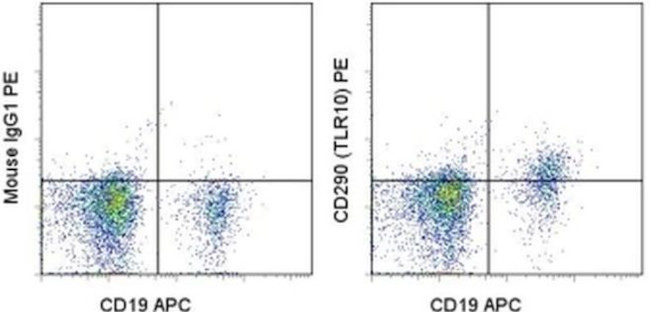Search Thermo Fisher Scientific
Invitrogen
CD290 (TLR10) Monoclonal Antibody (3C10C5), PE, eBioscience™
FIGURE: 1 / 1
CD290 (TLR10) Antibody (12-2909-42) in Flow

Product Details
12-2909-42
Species Reactivity
Published species
Host/Isotype
Recommended Isotype Control
Class
Type
Clone
Conjugate
Excitation/Emission Max
Form
Concentration
Purification
Storage buffer
Contains
Storage conditions
Shipping conditions
RRID
Product Specific Information
Description: This 3C10C5 monoclonal antibody reacts with human CD290, which is also known as Toll-like receptor 10 (TLR10). This type I transmembrane glycoprotein is expressed on B cells, monocytes, regulatory T cells (Tregs), and plasmacytoid dendritic cells. Moreover, CD290 expression is dependent on Foxp3 and NFAT in Tregs. Studies demonstrate that CD290 can self-dimerize, as well as heterodimerize with other members of the TLR family such as TLR1 and TLR2. Ligand binding results in association of the receptor with the adapter molecule MyD88 and subsequent activation of signaling pathways. Although the ligands of CD290 remain undefined, this receptor has been associated with the immune response against microbial and fungal infection and autoimmune diseases such as Crohn's disease and systemic lupus erythematosous.
Applications Reported: This 3C10C5 antibody has been reported for use in flow cytometric analysis.
Applications Tested: This 3C10C5 antibody has been pre-titrated and tested by flow cytometric analysis of normal human peripheral blood cells. This can be used at 5 µL (0.25 µg) per test. A test is defined as the amount (µg) of antibody that will stain a cell sample in a final volume of 100 µL. Cell number should be determined empirically but can range from 10^5 to 10^8 cells/test.
Excitation: 488-561 nm; Emission: 578 nm; Laser: Blue Laser, Green Laser, Yellow-Green Laser.
Filtration: 0.2 µm post-manufacturing filtered.
Target Information
The protein encoded by this gene is a member of the Toll-like receptor (TLR) family which plays a fundamental role in pathogen recognition and activation of innate immunity. TLRs are highly conserved from Drosophila to humans and share structural and functional similarities. They recognize pathogen-associated molecular patterns (PAMPs) that are expressed on infectious agents, and mediate the production of cytokines necessary for the development of effective immunity. The various TLRs exhibit different patterns of expression. This gene is most highly expressed in lymphoid tissues such as spleen, lymph node, thymus, and tonsil. Its exact function is not known. Multiple alternatively spliced transcript variants encoding the same protein have been found for this gene.
For Research Use Only. Not for use in diagnostic procedures. Not for resale without express authorization.
How to use the Panel Builder
Watch the video to learn how to use the Invitrogen Flow Cytometry Panel Builder to build your next flow cytometry panel in 5 easy steps.
Bioinformatics
Protein Aliases: CD290; MGC104967; MGC126398; MGC126399; Toll-like receptor 10
Gene Aliases: CD290; TLR10; UNQ315/PRO358
UniProt ID: (Human) A8K7L1
Entrez Gene ID: (Human) 81793

Performance Guarantee
If an Invitrogen™ antibody doesn't perform as described on our website or datasheet,we'll replace the product at no cost to you, or provide you with a credit for a future purchase.*
Learn more
We're here to help
Get expert recommendations for common problems or connect directly with an on staff expert for technical assistance related to applications, equipment and general product use.
Contact tech support

